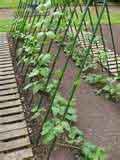January
- Finalise the plan of your plot – have you decided what is going where?
- When the soil is dry enough fork it through
- Make sure your tools are cleaned ready to go
- Order potatoes and start to chit them towards the end of the month (doing this in egg boxes is a nifty way).
- Prune your fruit trees
- Force rhubarb by covering the crown with a bucket
- Get organised; prewrite plant labels.
- Collect and clean seed trays.
- Stock up on canes, pots, netting etc.
You sould still be eating your own, home grown;
Brussel Sprouts



Winter cabbages
Leeks
Parsnips
Spinach
Swedes
Hardy herbs
Tips
- Packs of lolly sticks can be found in bargain shops; these make good, cheap plant labels. Write on them with an HB pencil and it won’t fade – you will remember what you have planted where!










 Many people say that you should plant your potatoes on Good Friday – and mine are indeed out – but it is still quite cold, mound earth over any shoots to protect them from the frost.
Many people say that you should plant your potatoes on Good Friday – and mine are indeed out – but it is still quite cold, mound earth over any shoots to protect them from the frost.


















